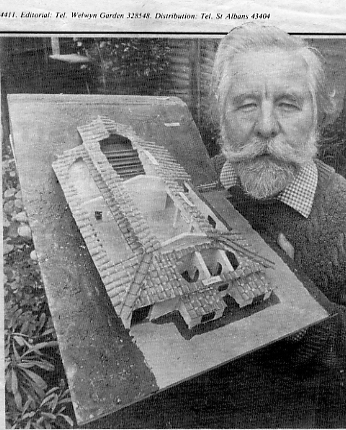Off season we used to walk along pipelines (these were being dug across the country thanks to the introduction of natural gas) looking for (and every often finding) old pottery and signs of ancient settlements.
It was a great thing to do and I'm sorry I gave it up, probably for beer drinking. The accompanying cuttings featuring Rook tell something about the man. He was/ is a great enthusiast and he taught me everything I know about archaeology (which is not much but could have been a lot less).
In particular he taught me that it made sense to leave the great Roman city Verulamium alone until techniques improve. I very much doubted this at the time, but it is remarkable how much things have changed in that half century.
Even so I believe they are still mostly leaving Verulamium alone.

Picture by David Satchel, Welwyn Times date unknown
Dreams of building an authentic Roman Bath house are nearer reality for Welwyn archaeologist Tony Rook.
Mr Rook, of Mill Lane, Welwyn, has harboured plans of building a full-scale working replica since discovering an original bath site under the A1.
Now his project, which could cost a final £50,000, has been backed by new homes developer Fairview.
Fairview, who are building in Woolmer Green, have paid towards Mr Rook's costs in making a model of the baths.
Now the model will be shown to potential sponsors.
"It is just about the best example of a Roman (bath) you can think of," said Mr Rook, "and could he used for educational and research purposes."
Potential sponsors interested in Mr Rook's project can contact him on Welwyn 5300.
Tony Rook has fond memories of amphorae in a garage and getting muddy in Welwyn
The 1960s were a hectic time for me. I had a new wife, a full-time job, my children were born: and I started the excavation of the Roman villa at Dicket Mead, Welwyn as a training dig. The Welwyn area was ravaged by developments, and I had to create an entirely amateur rescue team, there being then no professional field archaeologists in Hertfordshire.
One morning in 1966 I was forwarded a postcard from a member of the East Hertfordshire Archaeological Society. A man laying a gas pipe in the New Town of Welwyn Garden City, it said, had dug up a pot, which it illustrated. It was a Roman wine jar, a Dressel Ib amphora-a vessel associated with the so-called 'Celtic Chieftain Burials'.
The contractor, I found, had several amphorae in his garage, lying under sacking, like bombing-up time in my old squadron. 'If you want some', he said 'there's others still under the road that I didn't grub out', and he drew a map on a cigarette packet. I went straight to the site with some of my gang, and picked up, on the surface, a battered silver Neapolitan drinking cup, made about the beginning of the Christian era, an exciting, but awful, discovery. At that time only two similar cups had been found in Britain, exactly 60 years earlier, in the famous 'Chieftain Burials' at Welwyn.
Continued
Jonathan Brind